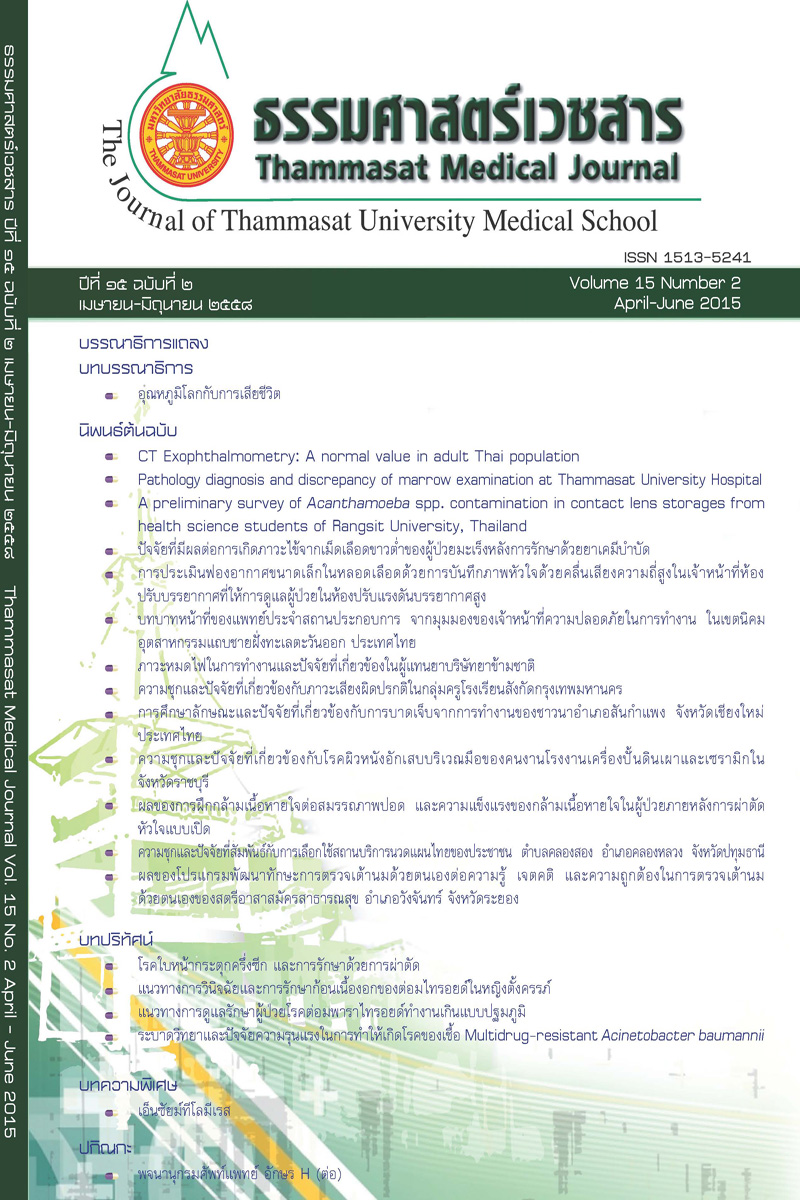Echocardiography evaluation of vascular microbubbles in hyperbaric chamber attendants
คำสำคัญ:
Microbubble, Hyperbaric chamber attendants, Multiplace hyperbaric chamber, Decompression stress, ฟองอากาศขนาดเล็ก, เจ้าหน้าที่ห้องปรับบรรยากาศ, ห้องปรับแรงดันบรรยากาศสูง, ความกดดันแฝงจากการลดความกดบทคัดย่อ
Introduction: The objectives of this study were to evaluate the decompression stress of hyperbaric chamber attendants at post decompression phase and to determine the factors related to higher decompression stress in the study population.
Method: This was a prospective study of 30 diving medical technicians undergoing Hyperbaric oxygen therapy (HBO) in multiplace hyperbaric chamber for the routine treatment of patients at Division of Underwater and Aviation Medicine, Royal Thai Naval Medical Department. Data were collected by self-administered questionnaire, health records reviews, results of annual physical fitness tests, and series of echocardiography after a routine HBO treatment. The data were analyzed using descriptive statistics; frequency, percentage and inferential statistics; Exact probability test and Spearman's correlation.
Result: Result of the decompression stress post-decompression, by Eftedal-Brubakk classification, 27 cases (90%) were in low level (Grade 0-1), 2 cases (6.67%) were in intermediate level (Grade 2), while 1 case (3.33%) was in high level (Grade 3-5). The highest bubbles were observed at 90 minutes post-decompression during movement (3 knee squats). Body Mass Index (BMI), requirement of routine medication, additional pressure-related works elsewhere were correlated with higher decompression stress.
Discussion and Conclusion: Hyperbaric chamber attendants exposed to the decompression stress at low level, considerably “acceptable”. Some factors i.e. BMI, medication, low physical fitness were correlated with high decompression stress that could lead to the substantial degree of clinical decompression sickness, a rare condition but can possibly pose severe consequences and permanent health sequalae. Thus, working in such environment, health surveillance and health promotion should be emphasized in order to work properly and safely.
Key words: Microbubble, Hyperbaric chamber attendants, Multiplace hyperbaric chamber, Decompression stress
การประเมินฟองอากาศขนาดเล็กในหลอดเลือดด้วยการบันทึกภาพหัวใจด้วยคลื่นเสียงความถี่สูงในเจ้าหน้าที่ห้องปรับบรรยากาศที่ให้การดูแลผู้ป่วยในห้องปรับแรงดันบรรยากาศสูง
ธนวัฒน์ ศุภนิตยานนท์*, พรชัย สิทธิศรัณย์กุล**, ธนษวัฒน์ ชัยกุล*, พัฒนชัย เฉลิมวรรณ์***
* กองเวชศาสตร์ใต้น้ำและการบิน กรมแพทย์ทหารเรือ
** ภาควิชาเวชศาสตร์ป้องกันและสังคม คณะแพทยศาสตร์ จุฬาลงกรณ์มหาวิทยาลัย
*** กองอายุรเวชกรรม โรงพยาบาลสมเด็จพระปิ่นเกล้า กรมแพทย์ทหารเรือ
บทคัดย่อ
บทนำ: การศึกษาครั้งนี้มีวัตถุประสงค์เพื่อศึกษาความกดดันแฝงจากการลดความกดภายหลังการให้การพยาบาลภายในห้องปรับแรงดันบรรยากาศสูงของเจ้าหน้าที่ห้องปรับบรรยากาศและปัจจัยเสี่ยงที่เกี่ยวข้อง
วิธีการศึกษา: เป็นการศึกษาแบบการศึกษาไปข้างหน้า (Prospective study) กลุ่มตัวอย่างคือ เจ้าหน้าที่ห้องปรับบรรยากาศที่เข้าดูแลผู้ป่วยภายในห้องปรับแรงดันบรรยากาศสูง กองเวชศาสตร์ใต้น้ำและการบิน กรมแพทย์ทหารเรือจำนวน ๓๐ ราย โดยรวบรวมข้อมูลจากแบบสอบถาม ข้อมูลสุขภาพจากเวชระเบียน ผลการทดสอบสมรรถนะทางกายประจำปี และการบันทึกภาพด้วยคลื่นเสียงความถี่สูง (Echocardiography) วิเคราะห์ข้อมูลโดยการหาความถี่ ร้อยละ และทดสอบความสัมพันธ์ระหว่างระดับฟองอากาศกับปัจจัยที่เกี่ยวข้องโดยสถิติ Exact probability test และ Spearman's correlation
ผลการศึกษา: เจ้าหน้าที่ห้องปรับบรรยากาศพบความกดดันแฝงจากการลดความกดภายหลังการให้การพยาบาลภายในห้องปรับแรงดันบรรยากาศสูงด้วย Echocardiography ตามเกณฑ์ของ Eftedal-Brubakk (EB Grading) ในระดับตje(Grade 0 - 1) จำนวน ๒๗ ราย คิดเป็นร้อยละ ๙๐ ระดับปานกลาง (Grade 2) จำนวน ๒ ราย คิดเป็นร้อยละ ๖.๖๗ และระดับสูง (Grade 3 - 5) จำนวน ๑ ราย คิดเป็นร้อยละ ๓.๓๓ โดยพบฟองอากาศสูงที่สุด ณ เวลา ๙๐ นาทีหลังการลดความกด และพบในท่าเคลื่อนไหว (งอเข่า ๓ ครั้ง) มากกว่าขณะพัก โดยพบว่าดัชนีมวลกาย โรคประจำตัวที่ต้องรับประทานยารักษาต่อเนื่อง การทำงานอื่นที่เกี่ยวข้องกับการเพิ่มและลดความดันแวดล้อม มีความสัมพันธ์กับปริมาณความกดดันแฝงที่สูงในกลุ่มตัวอย่าง
วิจารณ์ และสรุปผลการศึกษา: เจ้าหน้าที่ห้องปรับบรรยากาศมีความเสี่ยงจากโรคจากการลดความกดในระดับต่ำจากการประเมินด้วย Echocardiography อย่างไรก็ตามพบระดับความกดดันแฝงที่แตกต่างกันตามปัจจัยต่างๆ เช่น ดัชนีมวลกายสูง ประวัติการรับประทานยาเป็นประจำ และสมรรถนะทางกายต่ำ ดังนั้นจึงควรมีการเฝ้าระวังป้องกันเพื่อลดโอกาสการเกิดโรคจากการลดความกด ซึ่งเป็นโรคที่มีความรุนแรงสูงและเกิดผลกระทบทางสุขภาพอย่างถาวรได้
คำสำคัญ: ฟองอากาศขนาดเล็ก, เจ้าหน้าที่ห้องปรับบรรยากาศ, ห้องปรับแรงดันบรรยากาศสูง, ความกดดันแฝงจากการลดความกด



